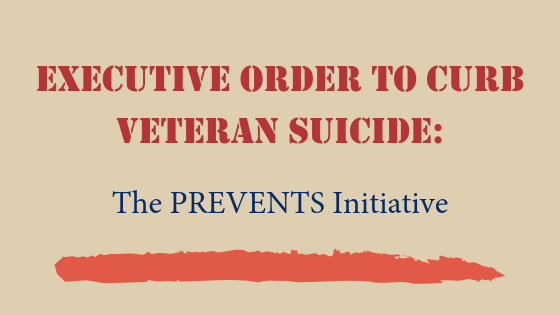
With an estimated 20 US veterans committing suicide every day, America is facing a national crisis. On March 5, 2019, by Executive Order, President Donald Trump addressed the tragedy and asserted that, “as a nation, we must do better in fulfilling our solemn obligation to care for all those who have served our country.” He issued a national call to action to improve the lives of our nation’s veterans; recognized that collective efforts must begin with the common understanding that suicide is preventable and prevention requires more than intervention at the point of crisis; and established the Veteran Wellness, Empowerment, and Suiceide Pervention Task Force.
This task force, launched on June 17, 2019 and co-chaired by VA Secretary Robert Wilkie and Director of the White House Domestic Policy Council Joe Grogan, is charged with developing the “roadmap” for collaboration to prevent veteran suicide, the President’s Roadmap to Empower Veterans and End a National Tragedy of Suicide (PREVENTS Initiative).
They also must submit, to the President, proposed legislation to establish a grant program to encourage state and local action and set a “national research strategy to improve the coordination, monitoring, benchmarking, and execution of public- and private-sector research related to the factors that contribute to veteran suicide.” As President Trump said, “(o)ur mission is to mobilize every level of American society to save the lives of our great Veterans and support our Veterans in need.”
Who's In This Task Force?
The cabinet level Veteran Wellness, Empowerment, and Suicide Prevention Task Force includes:
(i) the Secretary of Defense;
(ii) the Secretary of Labor;
(iii) the Secretary of Health and Human Services;
(iv) the Secretary of Housing and Urban Development;
(v) the Secretary of Energy;
(vi) the Secretary of Education;
(vii) the Secretary of Homeland Security;
(viii) the Director of the Office of Management and Budget;
(iv) the Assistant to the President for National Security Affairs; and
(x) the Director of the Office of Science and Technology Policy,
And any other pertinent figure or organization vital to the compiling of solutions.
The task force must fulfill its charge within 365 days of President Trump’s Executive Order, by March 2020. So far, everything appears to be on schedule to be completed in time and in the manner President Trump prescribed. The President specifically emphasized that the “roadmap must be holistic and encompass the overall health and well-being of our Nation’s veterans” and strengthen collaboration in an “all hands-on approach.”
He also pointed out that nearly 70% of veterans do not use the VA system for care after their service in the military is over and that, therefore, the need to reach veterans outside of the VA network is vital. In fact, one of the strong points of the Executive Order seems to many to be its focus on reaching out to veterans instead of requiring the veteran to shoulder most of the work. It calls for entities to be proactive in helping our heroes "rather than [using] a passive system wherein the onus for engagement is placed on veterans."
Following Arizona's Example
“The path going forward is in partnership,” said Thomas Winkle, Director of the Arizona Coalition for Military Families. Arizona, a short time ago, had one of the highest suicide rates among National Guard members. They took an innovative approach to addressing the prevention, intervention, and post prevention of stress and trauma among military members and their families.
These programs, specifically the Total Force Team and Be Resilient Programs, which both focused heavily on collaboration, radically reduced the suicide rate within the Arizona National Guard from the highest rate ever in 2010 to zero for a 36 month period and increased effective utilization of services for guardsmen and their families. Winkle is confident it can be scaled for other communities as well.
Dr. Barbara Van Dahlen, a prestigious figure in the area of veteran mental health, has agreed to be the Executive Director of the PREVENTS initiative. As founder and president of Give an Hour, a non-profit network of service care providers offering free help to veterans and their families, she is a thought-leader and a visionary of large-system change for our veterans and mental health stigmas alike.
What About Funding?
The President’s Executive Order does not specify whether new appropriations will be needed for funding. However, there has already been an increase in VA budgets by $8.6 billion for mental health services and $206 million for suicide prevention. This, coupled with the MISSION Act, the expansion of telehealth services, and the anticipated roadmap, will hopefully go a long way towards the President’s goal of improved quality of life for our nation’s veterans and aspiration to end veteran suicide.
